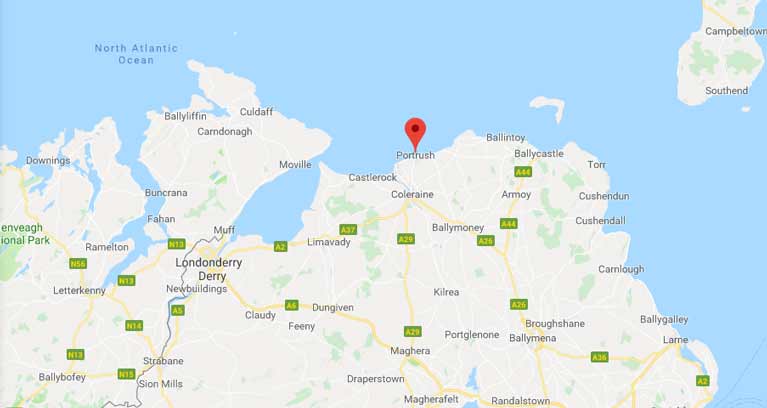Thirty years ago, on February 13th 1989, the volunteer crew of Portrush RNLI Lifeboat launched in dreadful conditions to reports of two Spanish trawlers in difficulty. This was when the famous Portrush picture was taken by photographer Ian Watson. Crew member Mark Mitchell tells the story:
On a February afternoon in 1989, when I was 21, we were asked to go to the aid of two Spanish trawlers floundering off Donegal. Nothing unusual - except for the weather. The wind speed indicator at the top of the mast was screaming at 113.5mph northerly, straight on shore. I had done several call-outs but this was the most dangerous to date.
We sat at the harbour entrance for what seemed like a lifetime as we strapped in and prepared. We were all well-experienced seafarers, but we knew this one was going to be bad.
As one mountainous wave after another surged past the harbour mouth, the Coxswain saw his chance - he was looking for a trough we could get ourselves into - and slammed the throttles forward. Almost a thousand horsepower launched us into the maelstrom. I was terrified. But we weren't allowed to say so because we were men in a man's world. In those days we couldn't show our fear.
Seconds later, the seventh wave caught us and we were now suddenly on our side, surfing down a wall of white water towards the trough.
"Seconds later, the seventh wave caught us and we were now suddenly on our side, surfing down a wall of white water towards the trough"
In a lesser boat we would have been dead, but the legendary stability of the **Richard Evans Arun Class Lifeboat pulled us back to something resembling an even keel and we turned to face the next one.
It was obvious, however, that the Deputy 2nd Coxswain, Terry Murdoch's ribs were broken. Despite the injury, he went on doing his job at the radar. At the end of the day, there are only seven of us on that boat doing the job - so we go on if we can.
The next wave we climbed, climbed, climbed before it was plucked away from below us. Now 28 tonnes of boat and men were falling, falling, falling, our propellers beating in clear air. Surely no boat could take the inevitable impact! As we hit the wave's trough, the sea exploded around us. We were now completely submerged.
 The scene of the action on Ireland’s north coast. The Portrush lifeboat eventually found a safe berth at Greencastle in Donegal on the entrance to Lough Foyle, three miles along the coast from Moville.
The scene of the action on Ireland’s north coast. The Portrush lifeboat eventually found a safe berth at Greencastle in Donegal on the entrance to Lough Foyle, three miles along the coast from Moville.
The constantly moving window wipers, designed to quickly clear heavy spray, were now stopped by the force of the sea, their powerful motors screaming in protest. Every rivet and bolt shuddered as the Richard Evans fought her way back to the surface.
But then there we were - on the next crest. The next few waves were a groundhog day but, as mariners will know, a boat needs her sea room - her room to manoeuvre - and as we broke out of the bay and into the open sea the waves, though giant, became more predictable and we could now 'read' them and brace ourselves for each impact.
Just then the radio message came through. The two Spanish Trawlers which had been in difficulty were now in the shelter of Lough Swilly and no longer in any danger. The message said we could return home - but we couldn't. No boat could turn in these conditions without inevitable capsize. We had no choice but to go on, on towards the shelter of Lough Foyle and the haven of Greencastle, relatively sheltered from winds of this direction.
Normally a 45-minute passage, we battled on for three hours as the coxswain played the throttle and wheel to keep us upright. At last, the welcome shelter of Inishowen Head was sometimes visible above the giant waves - but the sea wasn't going to give up that easily. As the might of the Foyle pushed against the sea, the waves seemed as big as the Himalayas.
We were to almost suffer a 'pitchpole' - where the boat is tossed stern over bow like a child would casually discard a stick. Not a survivable prospect. Once again, the legendary Arun fought off the advance and we were within the safety of the mighty Lough. I unstrapped and with my colleagues went forward to prepare the fenders and ropes for mooring up.
The force of the wind was like an unseen hand. I needed the last of my waning strength to fight my way forward. Then we were there - alongside
Mechanic Anthony Chambers pushed the buttons that would bring the faithful Caterpillar diesels to a well-earned rest. And there it was. Silence. For the first time that night there was an almost painful silence. And there we were, alive and alone with our own thoughts.
































































